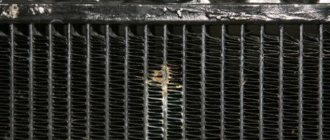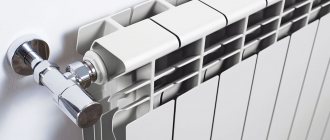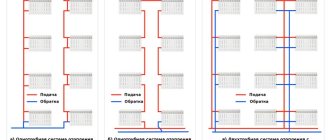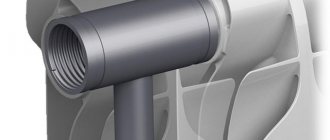The characteristics of aluminum batteries can be quantitative and qualitative. The first involves comparing heating elements in terms of weight and size and the power of the emitted heat flow. The latter provide for the specific design and technological features of production.
Household aluminum heating radiator Source mtdata.ru
Casting
In this case, each section is made separately from silumin (an alloy of aluminum and silicon). The part of silicon in the material does not exceed 12%, which is quite enough to obtain the required strength. The casting process takes place under high pressure conditions, which allows the sections to be given any desired shape. Finished products are designed for a working pressure of 6-16 atm. To achieve free circulation of coolant inside the radiators, the water channels are expanded. Improving the strength of batteries is achieved by increasing the wall thickness.
Extrusion
The word "extrusion" is translated as "squeezing out". This method produces individual radiator elements, after which they are assembled into a common structure. This mainly concerns vertical elements, the raw material for which is aluminum with additives. As for the collector, it is poured out of silumin: the extrusion method in this case is used much less frequently. After this, all parts are pressed to secure them together. The extrusion method is an order of magnitude cheaper than casting, but the products obtained in this way cannot be improved during operation.
Fins
The fins serve to increase the total heat transfer area of the heating device. Modern models use various design solutions that make fins more efficient.
The efficiency of heat transfer is increased by introducing additional fins into the structure, as well as by profiling convection channels between the ribs. In Tenrad radiators, the channels form a confuser, due to which the air flow speed increases, which increases the intensity of convective heat transfer. The outer edges of the ribs are rounded to increase injury safety.
Anodized radiators
High quality purified aluminum is used to make these heaters. Thanks to the use of anodic oxidation, the structure of the metal changes, after which it is practically not afraid of corrosion. To switch individual components, not traditional nipples are used, but special couplings (they are mounted outside the device). Thanks to this, the internal surfaces of the anodized radiator are very smooth, which increases the level of heat transfer compared to conventional aluminum batteries. The ability of the heaters to withstand operating pressures of up to 70 atm is also impressive. The cost of devices of this type is quite high.
Center distance
Standard sizes are 200, 350 and 500 mm: these sizes are most often found on the plumbing products market. There are also radiators with non-standard center distances, varying from 200-800 mm. Before purchasing a battery, you need to carefully measure the location of its installation (usually under the windowsill). It is not recommended to use a too tight installation, because the heated air will not be able to circulate freely, and convection will be difficult.
The optimal gap from the floor to the battery is considered to be 10 cm: the same applies to the distance to the window sill. As for the side gaps, it is enough to leave 3 cm on each side. If the dimensions of the radiator are too large, you need to take a smaller device. For example, a battery with a center distance of 350 mm will have a height of 100 mm more. These points should be taken into account when choosing a suitable option.
Battery sizes
Common sizes of aluminum heating radiators are 500, 350 and 200 mm. They characterize the center-to-center distance between the collectors. There are also models on sale in which the center-to-center distance differs from the standard and reaches 800 mm or more.
Important! To calculate the height of the aluminum device, add 80 mm to the center-to-center distance indicated in the specifications.
Pressure
Typically, the accompanying documentation contains the characteristics of aluminum radiators, indicating the operating and pressure testing (the latter parameter is an order of magnitude higher). Sometimes there may be indications of maximum pressure, which often causes confusion. You need to know that it is at the operating pressure that the battery will be operated. Aluminum devices have a working pressure of 10-15 atm.
Central heating has a pressure of 10-15 atm, and heating mains have a pressure of almost 30 atm. For this reason, installing aluminum radiators in apartments with central heating is not recommended. As for private houses with autonomous heating, domestically produced boilers produce a pressure of no more than 1.4 atm. (this parameter is sometimes indicated in bars, which is the same thing). German-made boilers have a higher operating pressure - almost 10 bar: this is suitable for the use of aluminum radiators.
Crimping pressure parameters are no less important. As a rule, at the end of the heating season, the water is drained from the system. To start the heating again, it is necessary to check the tightness of the entire circuit. This is achieved by pressure testing, that is, testing in high pressure mode (usually it is 1.5-2 times higher than the operating indicators). Traditionally, crimping pressure can reach 20-30 atm. Most often, this procedure is carried out in centralized networks.
The large difference in operating pressure for apartment buildings and private buildings is explained by the different number of floors. Pressure helps determine the level to which the water reaches. Thus, one atmosphere is capable of raising water to a height of 10 meters. This is quite enough for a three-story house, but not enough for a four-story house. Utility services rarely adhere to the declared coolant supply regime. In some cases, even the most durable, expensive devices fail due to exceeding standards.
Therefore, it is desirable that the installed aluminum batteries have a certain pressure reserve. This will allow them to withstand pressure surges in the system. Having a pressure reserve, you don’t have to worry about the serviceability and efficiency of the batteries. The characteristics of aluminum heating radiators indicated by different manufacturers may differ. In addition to such units of designation as bar and atmosphere, megapascals (MPa) are also sometimes found. To convert to bar, 1 MPa is multiplied by 10.
Advantages and disadvantages of an aluminum heating device
Aluminum products have a number of positive qualities, which are the reason for the popularity of these products.
- Aluminum radiators weigh relatively little, which makes them easier to transport and allows you to install them yourself.
- Such batteries look attractive and can not only heat, but even decorate various rooms.
- The characteristics of the material and the well-thought-out design of the batteries result in high heat transfer. Aluminum batteries can significantly save heating costs by reducing the volume of coolant in each section.
- Such batteries quickly respond to changes in the coolant supply: they cool and cool almost instantly. This allows you to warm up the premises in a short time and increases the efficiency of thermostats, which also reduces heating costs.
- Powder coating simplifies battery maintenance and eliminates the need for periodic painting.
- There are models that can withstand high pressure.
- All this is combined with a relatively low price.
But such products also have several disadvantages that you need to know about before purchasing:
- Prefabricated devices use rubber sealing elements, which makes it impossible to use antifreeze as a coolant.
- Low protection from corrosive processes. To extend the operating period, it is necessary that the water has neutral acidity and does not contain abrasive particles that can damage the protective film.
- An accumulation of air may occur inside the heating device; to bleed it, it is necessary to equip the battery with an air vent.
- The weak point of such a battery is the threaded connections.
Yet, for the most part, the properties and features of aluminum heating devices make them ideal for heating systems.
Thermal characteristics
Aluminum batteries give off almost 50% of their heat through rays. The remaining part of the heating occurs by convection of air flows between the lower and upper parts of the radiator. The ribbed surface on the inside of the sections contributes to a significant increase in heat transfer. Its coefficient is measured in watts: it is usually indicated for one section. For a clear example, let’s take a device with an interaxial distance of 500 mm. The heat transfer level of one section here can be from 100 to 150 W. To obtain the total result for thermal calculations, it is necessary to multiply this indicator by the number of sections.
It should be borne in mind that the higher the heat transfer of the radiator, the less its inertia. This helps to save money, so aluminum batteries have no equal in terms of efficiency. They are ahead of both classic cast iron and modern bimetallic products. To operate the system, water at a lower temperature will be required, which helps to increase the service life of the boiler.
Duration of operation
Traditionally, manufacturers of aluminum radiators provide a guarantee for their products for a period of 10-20 years, and well-known brands - 25 years. Practice shows that products of this type last much longer.
List of main characteristics of aluminum heating radiators:
- The center-to-center distance from the upper to the lower collector is from 200 to 500 mm;
- Working pressure – 6-16 atm.
- Thermal power – from 82-212 W.
- The weight of one section is from 1-1.47 kg.
- The volume of one section is from 250-460 ml.
- The limit coolant temperature is +110 degrees.
- Warranty – from 10-15 years.
Materials used
The core of the bimetallic radiator section is made of steel pipes. For batteries of normal strength (working pressure 16 - 20 atm), the core is made of carbon steel grade St.3 or its foreign analogues (for example, Tenrad radiators). The core (frame) of high-strength models is welded from stainless steel pipes. High-strength devices with a stainless steel core (for example, Biliner from Royal Thermo) can withstand burst pressures of more than 100 atm.
The outer part of bimetallic radiators is made of aluminum by injection molding. The extrusion method used in the production of some aluminum models cannot be used in this case, since a core must be placed inside the workpiece before forming begins. O-rings are made from heat-resistant silicone rubber.
Strengths and weaknesses of aluminum radiators
List of positive characteristics of aluminum batteries:
- Economical.
- Small mass. The weight of an aluminum battery greatly simplifies the installation and dismantling of devices.
- Possibility of temperature adjustment.
- The highest efficiency among all household radiator heaters.
- Presentable appearance, allowing the use of aluminum radiators both in ordinary homes and prestigious institutions.
Weak sides:
- Weakness of intersectional joints (leakages sometimes occur there).
- Unevenness in heat distribution: it is mainly accumulated by the ribbed part of the sections.
- Weakness of convection circulation.
- Low service life. The same cast iron batteries last much longer than 15-20 years.
- Internal gases may form.
- Excessive chemical activity of aluminum. This is the biggest drawback of this type of battery, because of which the presence of the slightest impurities in the coolant can provoke destructive processes on the internal walls.
- Low resistance to pressure changes.
Considering all these disadvantages, the scope of application of aluminum radiators is limited to autonomous heating systems with stable low pressure and a chemically neutral coolant. As for the installation of batteries of this type in ordinary apartments, there is even a special ban on this from the relevant authorities.
Most popular manufacturers
FARAL (Italy)
In our country, two models of this manufacturer are known - FARAL Green HP and FARAL Trio HP. They have center distances of 500 and 300 mm, with depths of 90 and 85 mm. The number of assembled sections is from 3 to 16: they are fixed to each other using steel nipples. Tightness is ensured by high-quality gaskets. Each product is tested at the factory with a pressure test of 24 bar, which allows further operation at 16 atm.
Global (Italy)
The devices of this company are distinguished by significant versatility, and can be installed both in apartments and in private houses. They are distinguished by elegance and original design. The most popular models are: Global ISEO and Global VOX. The standard distance between the axles here is 35o or 500 mm. Standard fasteners are used.
Sira Group (Italy)
Particularly popular with us are the TANGO, OPERA, ALUX, JAZZ, BLUES, SWING models made from extruded aluminum pipes. Radiators from Sira Group are available for sale in a wide variety of colors: special technology is used to treat their surface. For our country, a pressure of 30 bar is taken for crimping, which corresponds to a working pressure of 20 atm.
Fondital (Italy)
Models such as Calidor Super were developed specifically for the CIS countries: their natural conditions were taken into account. The manufacturing process is controlled by Russian standards (GOSTR RU.9001.5.1.9009) and European standards (EN 442). For this purpose, the method of casting aluminum alloy under pressure is used. The Calidor Super battery can comfortably withstand pressure surges of up to 50 atm. Due to the fact that the internal channels have an increased cross-section, they do not become clogged in the presence of impurities in the coolant. High strength of the devices is achieved due to thickening of the walls.
Power calculation methods
To determine the values, use 4 formulas:
- According to the linear dimensions of the room. To do this, you need to measure its length and width. According to building codes, 1 kW is required 10 square meters so the area is divided by 10. This option is less accurate because it does not take into account one important indicator taken into account in the following calculation.
- According to the full dimensions, to calculate which you also need to measure the height of the room. SNiP proposes to multiply the volume of the apartment by 41 W. So, for a room of 60 square meters , the power is: 60 * 2.7 * 41 = 6642 W.
- According to design features . This calculation is similar to the previous one, but takes into account the details:
- for each window add 0.2 kW ;
- for doors - 0.1 kW ;
- the amount is multiplied by 1.3 when the apartment is in a corner;
- by 1.5 if the power for a private house is considered;
- remember the “correction”, which depends on the geographical location of the object.
- into account the same as the structural calculation, as well as:
- thickness and material of insulation;
- what the floor, walls, ceiling are made of;
- ventilation of the room, if any.
Chinese products
The most famous and trusted manufacturers from China are Konner and Bilux. Their products are the cheapest. You should know that many well-known companies sell their licenses specifically to China, so today it is quite possible to purchase inexpensive and fairly high-quality Chinese aluminum heaters.
To do this, it is recommended to arm yourself with the following tips:
- You should carefully familiarize yourself with the parameters of the heating radiators indicated in the passport. If such information is missing or there is no accompanying documentation for the product, it is better to refrain from purchasing such a device.
- It is advisable to purchase batteries exclusively from a specialized store. The fact is that the market never gives a guarantee.
When purchasing any aluminum radiator, it is important to remember that devices of this type are very sensitive to water with a high pH level. This parameter should in no case exceed 7.5 units. Therefore, the use of aluminum heaters is permitted only if there is a coolant of appropriate quality in the pipeline.











